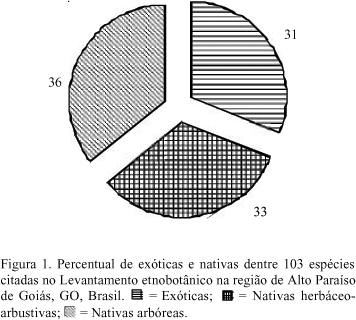Ethnobotany allows rescuing traditional knowledge of the most common uses given to the plants. It therefore, adds an extra-value to the cerrado species in the context of the economic development. This study was conducted in Alto Paraiso de Goiás town, located in the Plateaux named Veadeiros, distant of 230 km from Brasília. An ethnobotanical survey was conducted around the National Park of "Chapada dos Veadeiros", in Alto Paraíso municipality and in the town itself. Open-ended interviews were carried out with several people, trying to cover the variety of socio-cultural segments of the local society. Humans use a wide range of cerrado plant species from almost all the strata, herbs, shrubs and trees. The native biodiversity is used by the local people, with 69% of the 103 species quoted by them as useful plants, being native species. Amongst the top ten medicinal species ranked by the interviewed people, the following ones were quoted by everyone: chapéu de couro (Echinodorus macrophyllus (Kunth) Micheli), arnica (Lychnophora ericoides Mart.), native shrubs; jatobá (Hymenaea stigonocarpa Mart. ex Hayne), tingui (Magonia pubescens A. St.-Hil.) and barbatimão (Stryphnodendron adstringens (Mart.) Coville), native tree species and, two ruderal shrubs, carrapicho (Acanthospermum australe (Loefl.) Kuntze) and mastruz (Chenopodium ambrosioides L.). Besides the large potential for extrativism of plants, these resources are been depled without any plan for sustainable mangement.
ethnobotany; medicinal plants; Alto Paraiso de Goiás; Brazil


